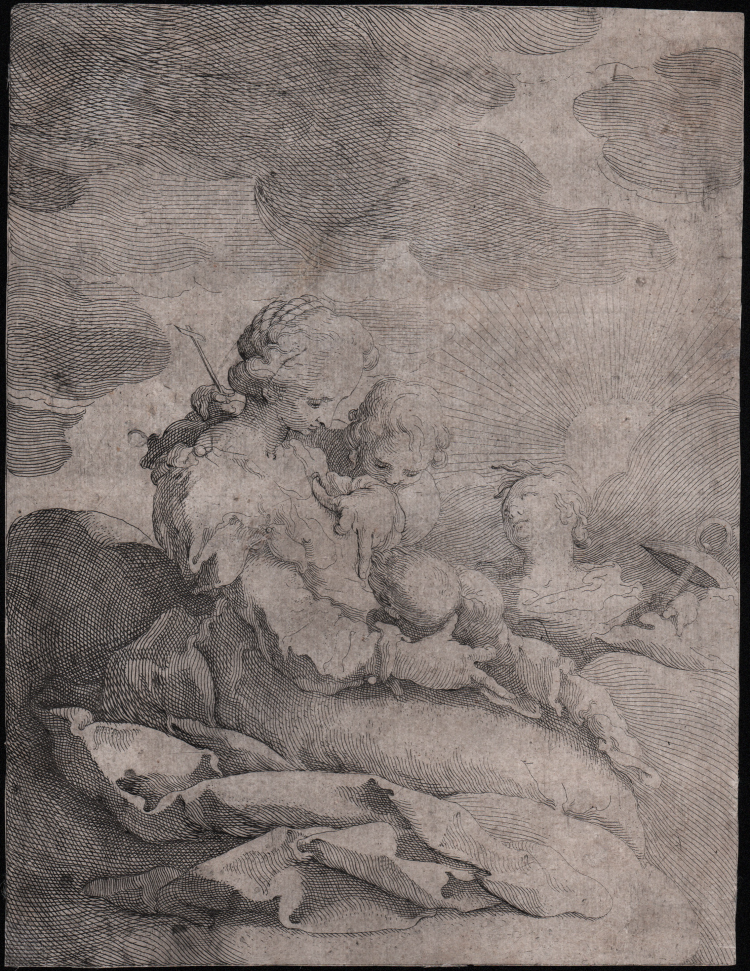



| Reference: | S42038 |
| Author | Gerrit Pietersz. Sweelink |
| Year: | 1593 ca. |
| Measures: | 185 x 245 mm |


| Reference: | S42038 |
| Author | Gerrit Pietersz. Sweelink |
| Year: | 1593 ca. |
| Measures: | 185 x 245 mm |
Etching, 1593 circa, unlettered.
Etremely rare first state, before any signature and the addition of the publisher's address of Johan Starter. Missing the lower edge with Latin inscription, two lines on two columns: Virtus quidem magna est FIDES, / Nec SPES Fide Virtus minor: / Sed, teste Christi Apostolo, / Est maxima harum CHARITAS.
Gerrit Pietersz. Sweelink (Amsterdam 1566 - before 1612), was an Amsterdam painter and draftsman. All of his etchings are extremely rare, known only in a handful of impressions. The Metropolitan Museum has four of his prints (one in a duplicate impression and a proof state of this work with ink additions and without the lower edge), the Albertina five (one duplicate) and the Rijksmuseum eight (three duplicates), including an example of the first state of this Faith, Hope and Charity, also without the lower part.
As noted from the curator of the Rijksmuseum “The cutting off of the bottom line of the inscription in the margin was probably prompted by its content. In the Latin caption, Love is called the most important virtue and, on the authority of the Apostle Paul, is placed above Faith. It is quite conceivable that a pious possessor took offence at this last line and removed it”.
Rather than creating a hieratic image of the Three Theological Virtues, Gerrit Pietersz. depicts them with the same tender approach and much the same compositional arrangement as he does the Holy Family. Charity sits on a bank of clouds with an infant lying in her lap; Faith, holding a tiny cross, peers over Charity’s shoulder looking at the child; and Hope, clutching her emblem, an anchor, looks up at the group with an expression of devotion. In the right background the sun breaks through the clouds, symbolizing God’s omnipresence and emphasizing how central these virtues are to Christianity.
The six etchings by Gerrit Pietersz, five of which are dated 1593, occupy a unique place in late 16th-century Dutch graphic art. They were made at a time when drudging printmakers in Goltzius’s workshop and elsewhere were producing very elaborate engravings that in execution were far removed from these freely rendered etchings. The free treatment is reminiscent of three etchings by Bartholomeus Spranger from around 1589, although the latter handling of line is far tauter. The etchings by Spranger and Pietersz exemplify the kind of work done by a painter as a means of exploring an unfamiliar technique. Given their scarcity, it is questionable whether such prints were ever printed in an edition of any magnitude. (G. Luijten).
A fine impression, with delicate tones, printed on contemporary laid paper and irregularly trimmed at the marginal line. Restoration work has been done on the lower and upper left corners and there are some superficial abrasions, but overall the work is in good condition.
Literature
F. W. H. Hollstein Dutch and Flemish Etchings, Engravings and Woodcuts. vols. 1-64, Amsterdam, 1954–2010, cat. no. XVI.110.3.
https://www.rijksmuseum.nl/nl/collectie/RP-P-2013-16
Gerrit Pietersz. Sweelink (Amsterdam 1566 –1612 circa)
|
An Amsterdam painter and draftsman, Gerrit Pietersz., moved to Haarlem in about 1588-89, to train with Cornelis Cornelisz., a Mannerist artist whose work had a lasting influence on him. While in Haarlem, he made six prints that are arguably his most innovative and beautiful works. Although Pietrsz. was drawn to printmaking while in Haarlem, he, unlike his contemporaries, eschewed the sharp swelling and tapering lines characteristic of Mannerist engraving and turned to etching instead. In contrast to the hard brilliance of the engravings by Goltzius and his school, Pietersz.’s etchings are loose and exuberant. The lines seem almost to have a life of their own, as we can see in the looping curls of Joseph’s beard and hair in The Rest on the Flight into Egypt, or the bunched drapery of St. Cecilia’s sleeve in St. Cecilia Playing the Organ.
Printmaking was something of an experiment for Pietersz. He only executed six etchings during his entire career, five of which are dated 1593. All of his etchings are extremely rare, known only in a handful of impressions.
|
Gerrit Pietersz. Sweelink (Amsterdam 1566 –1612 circa)
|
An Amsterdam painter and draftsman, Gerrit Pietersz., moved to Haarlem in about 1588-89, to train with Cornelis Cornelisz., a Mannerist artist whose work had a lasting influence on him. While in Haarlem, he made six prints that are arguably his most innovative and beautiful works. Although Pietrsz. was drawn to printmaking while in Haarlem, he, unlike his contemporaries, eschewed the sharp swelling and tapering lines characteristic of Mannerist engraving and turned to etching instead. In contrast to the hard brilliance of the engravings by Goltzius and his school, Pietersz.’s etchings are loose and exuberant. The lines seem almost to have a life of their own, as we can see in the looping curls of Joseph’s beard and hair in The Rest on the Flight into Egypt, or the bunched drapery of St. Cecilia’s sleeve in St. Cecilia Playing the Organ.
Printmaking was something of an experiment for Pietersz. He only executed six etchings during his entire career, five of which are dated 1593. All of his etchings are extremely rare, known only in a handful of impressions.
|